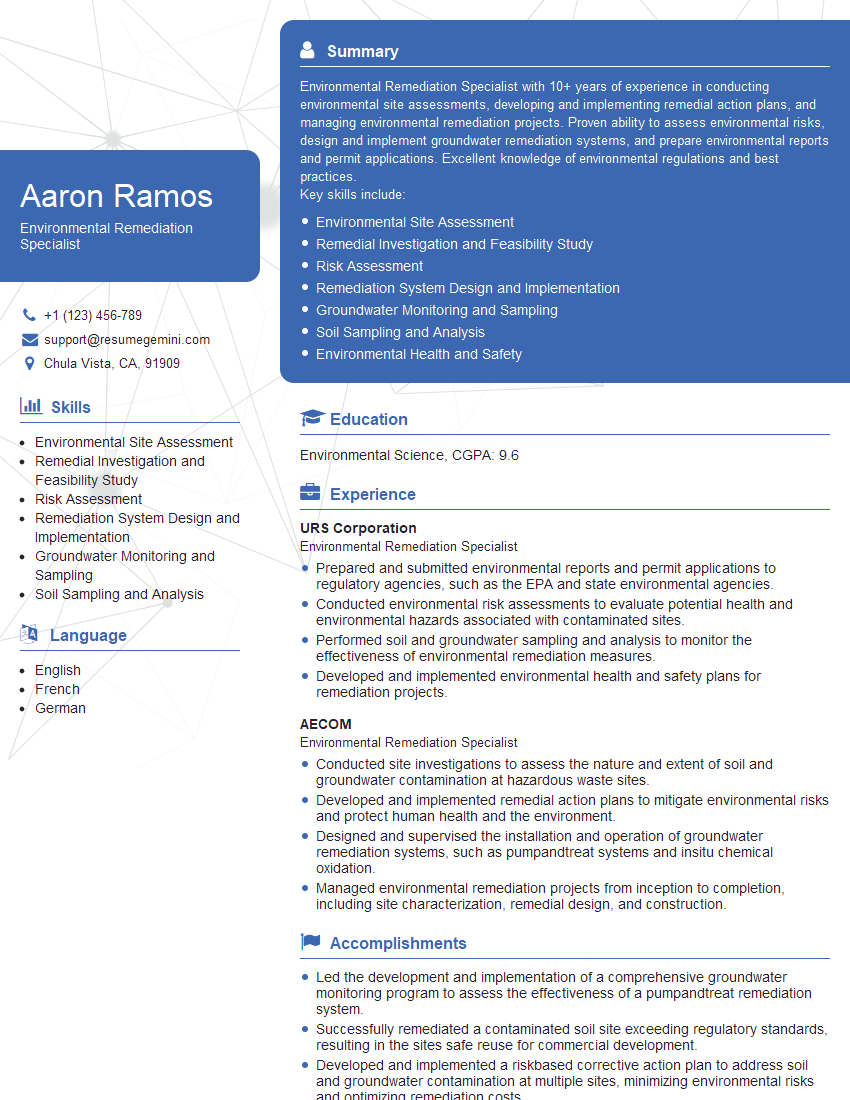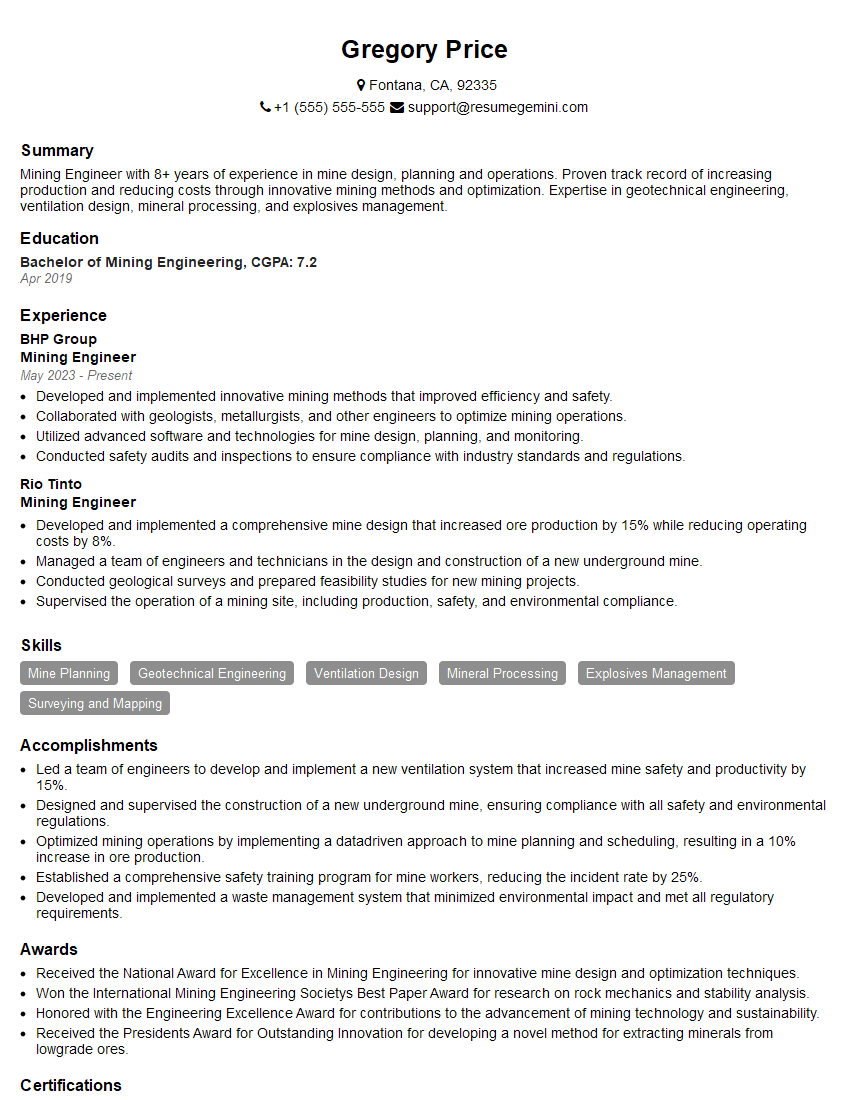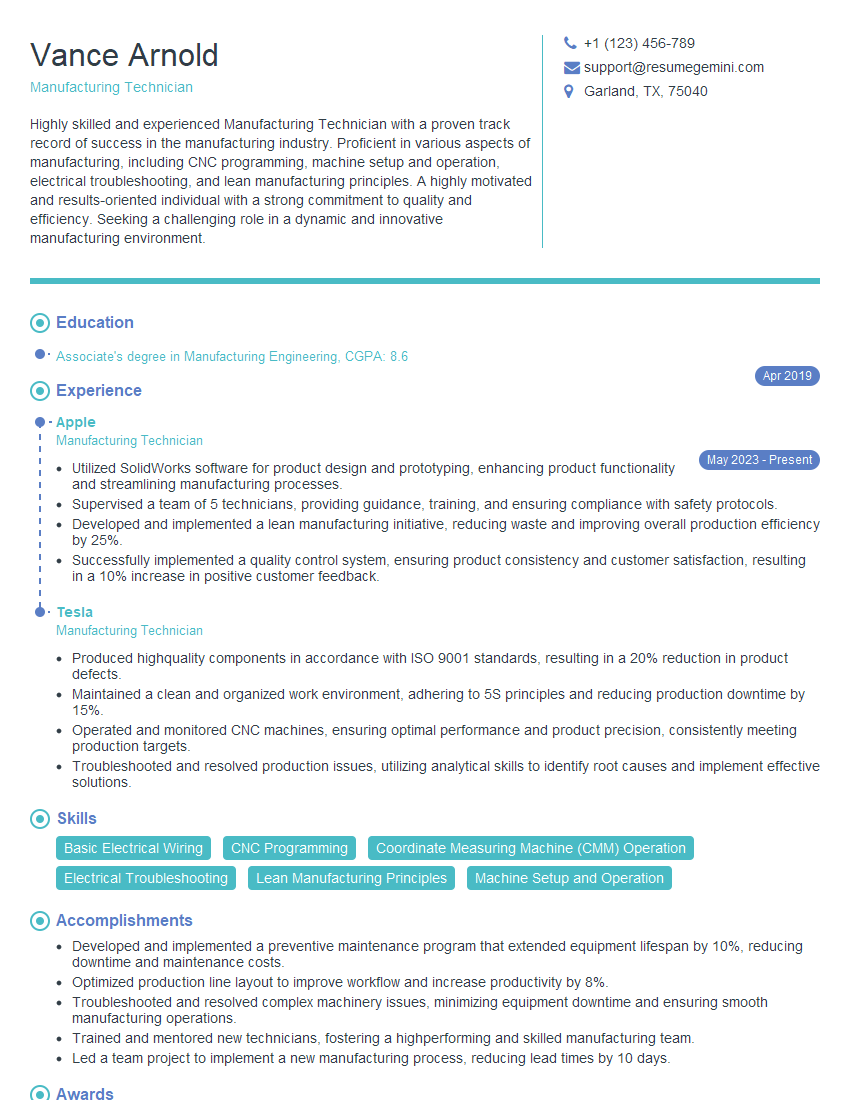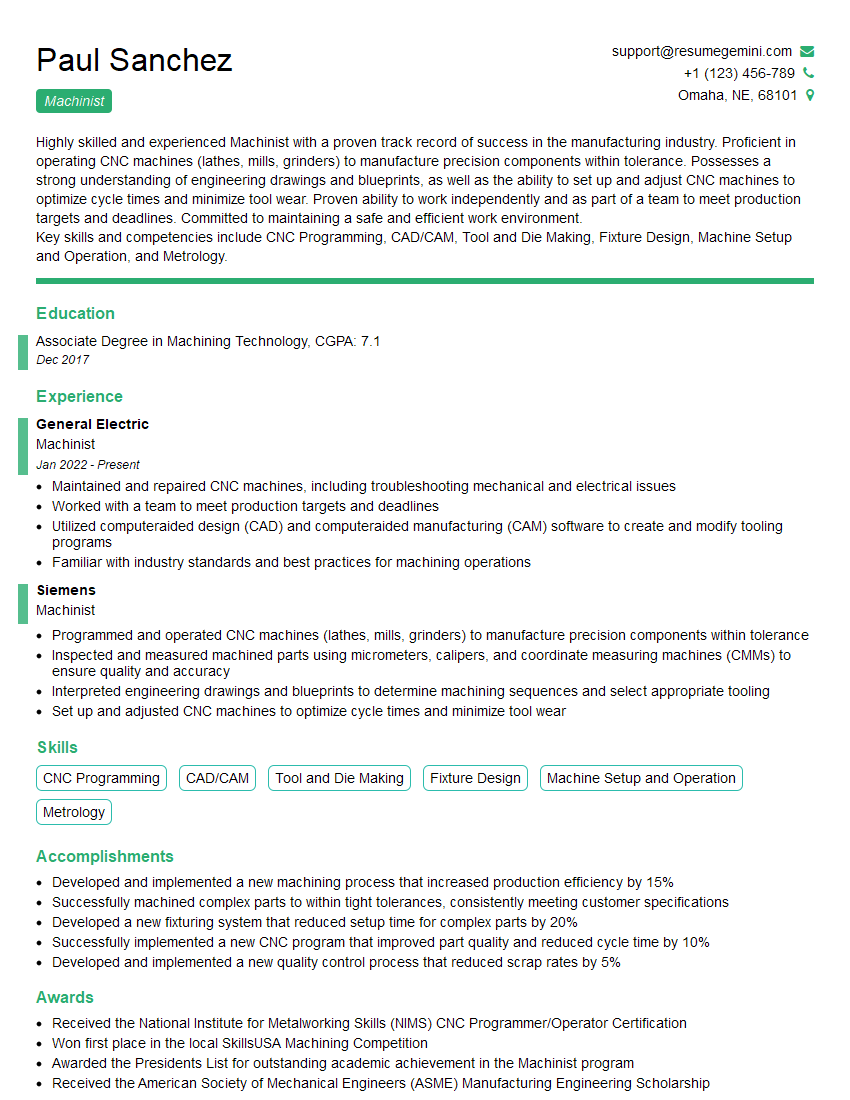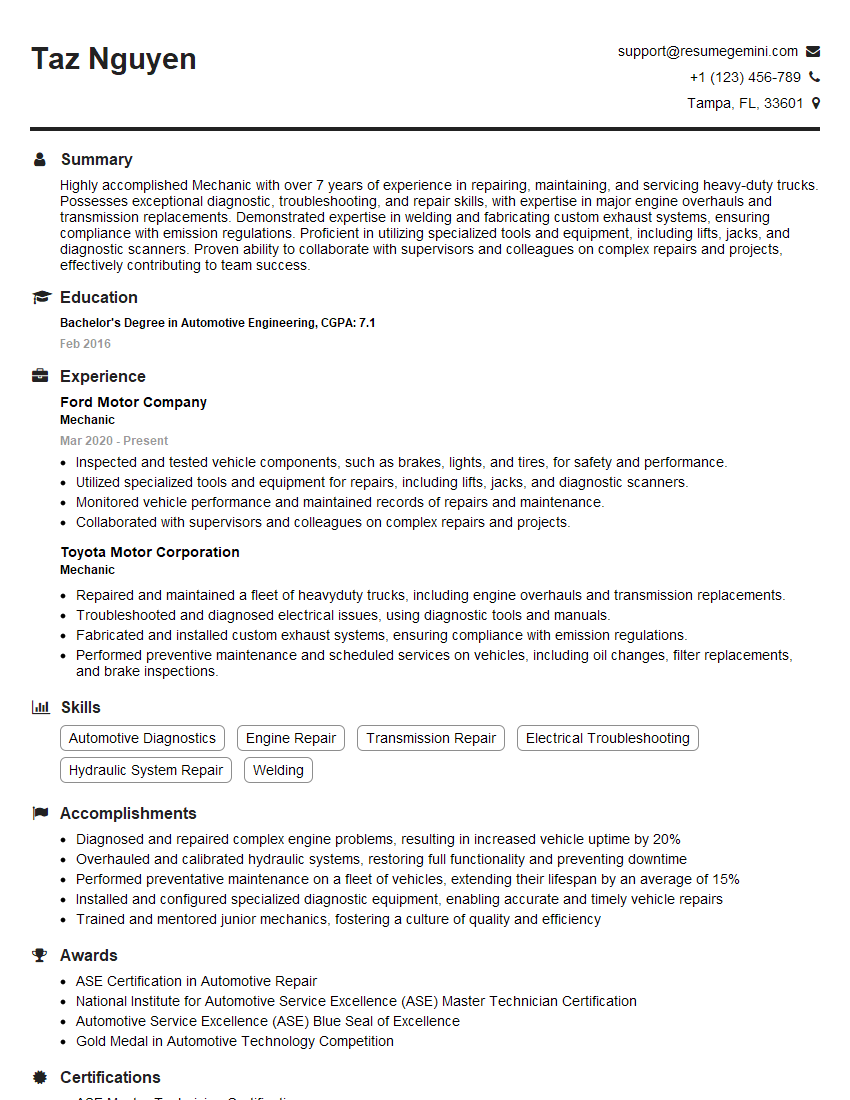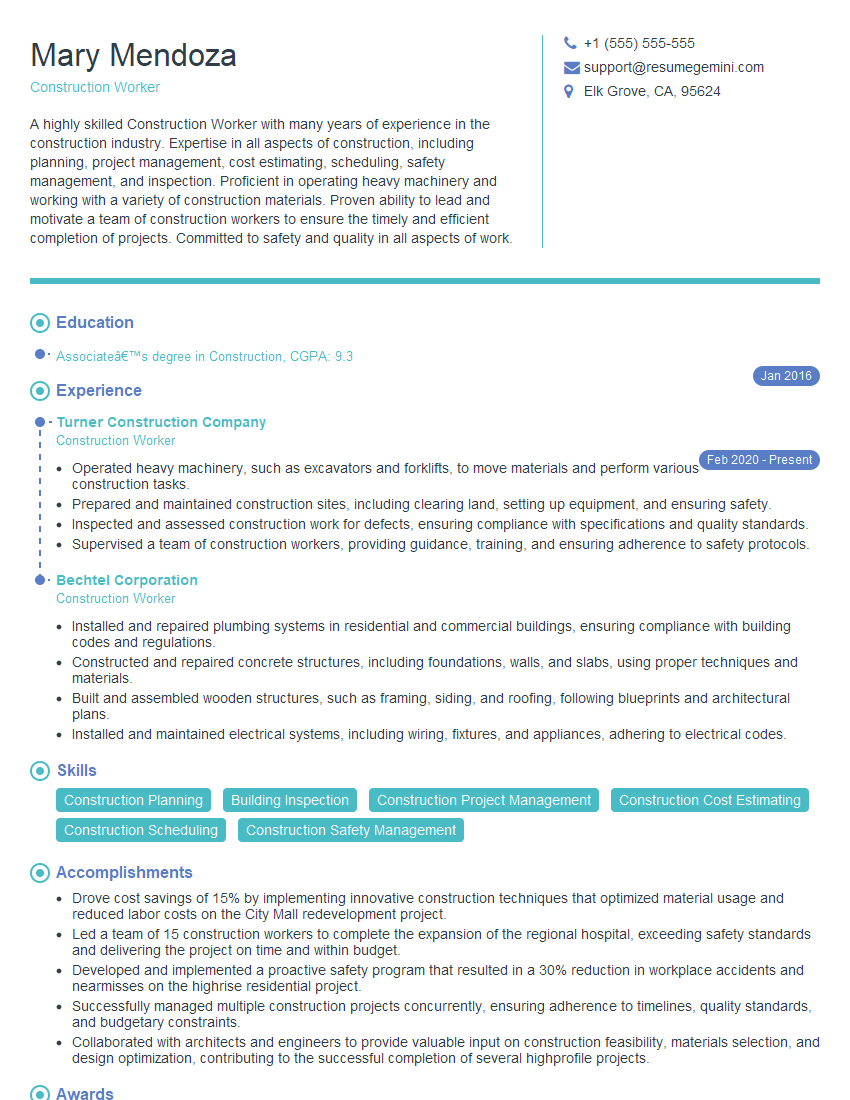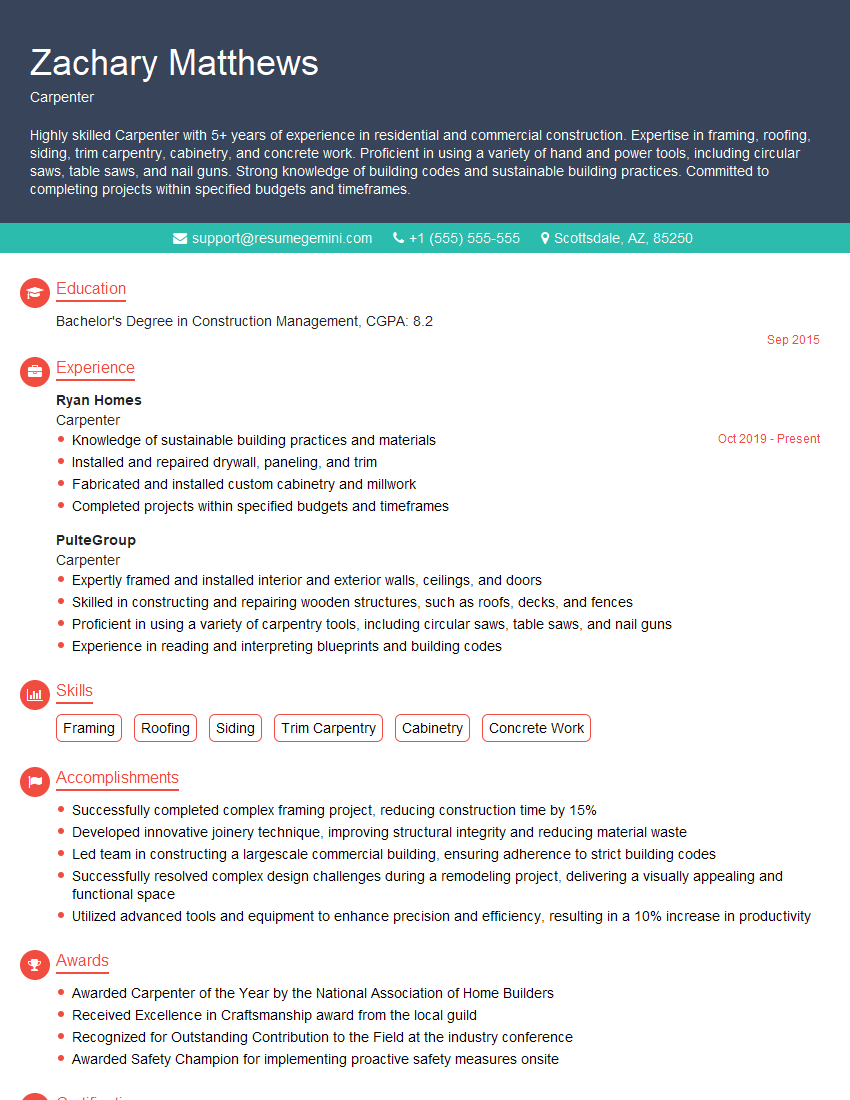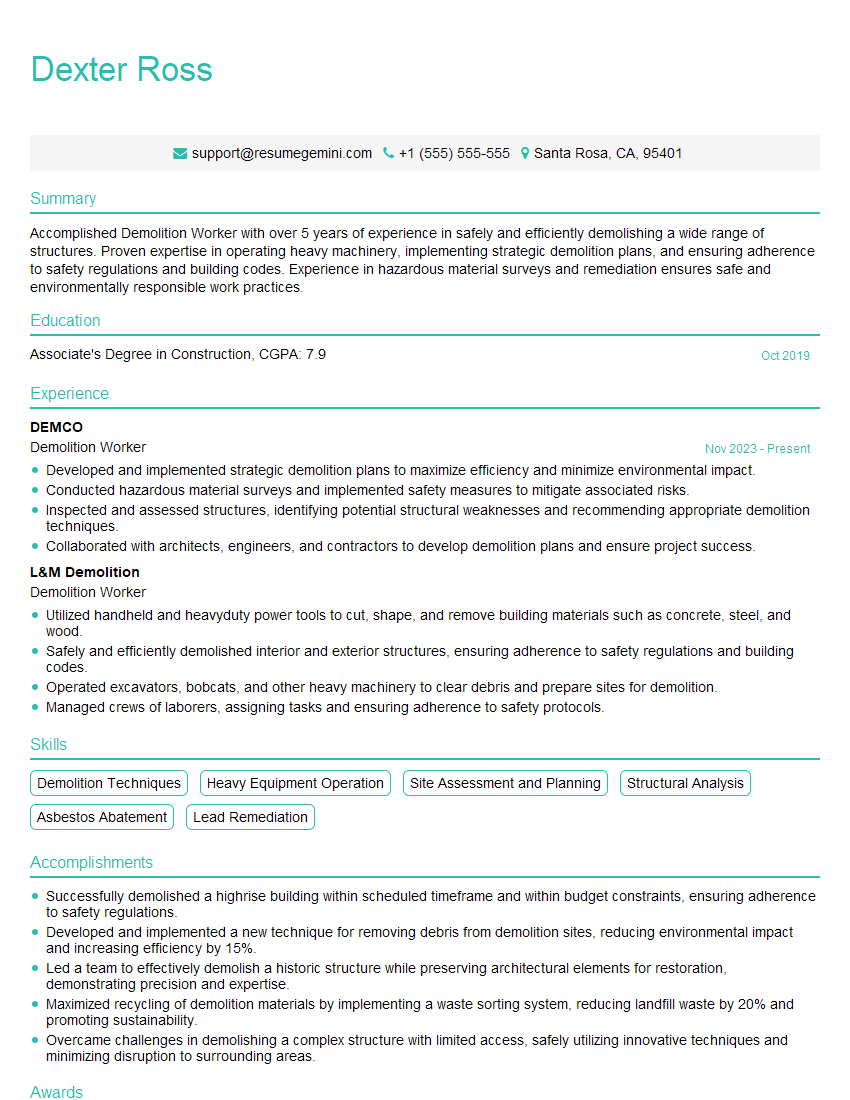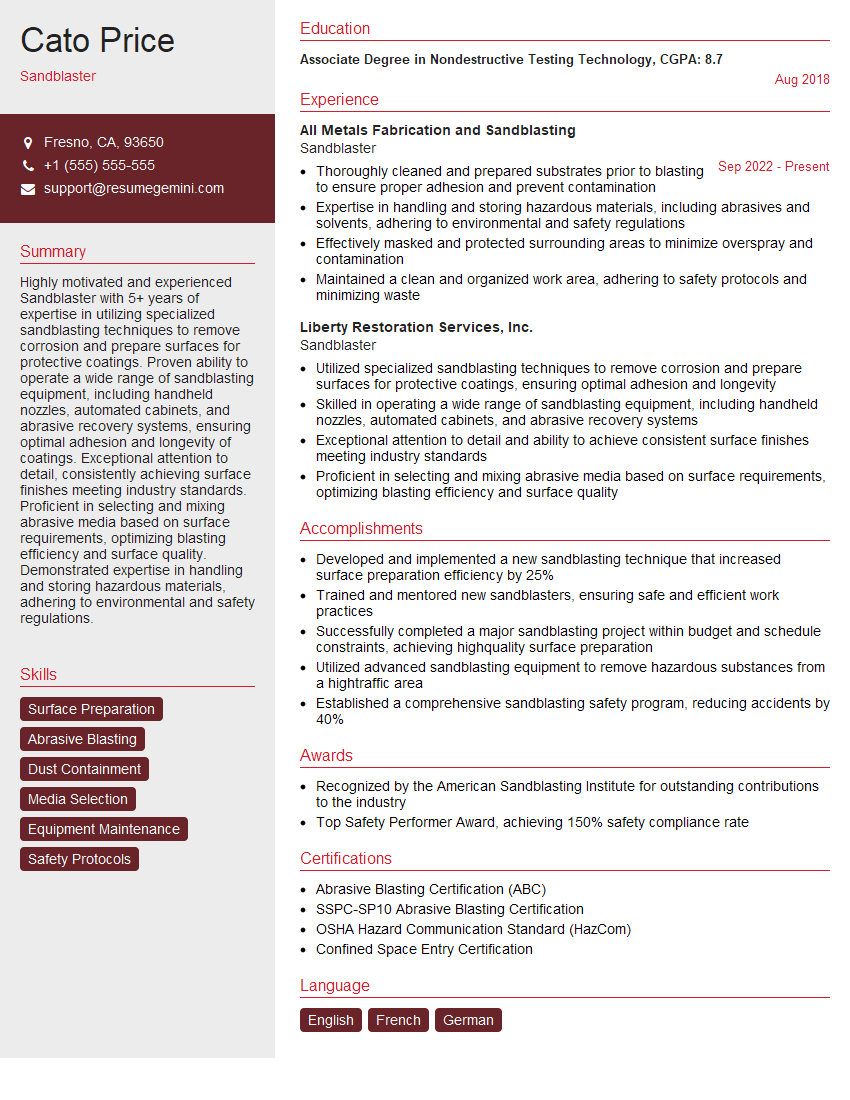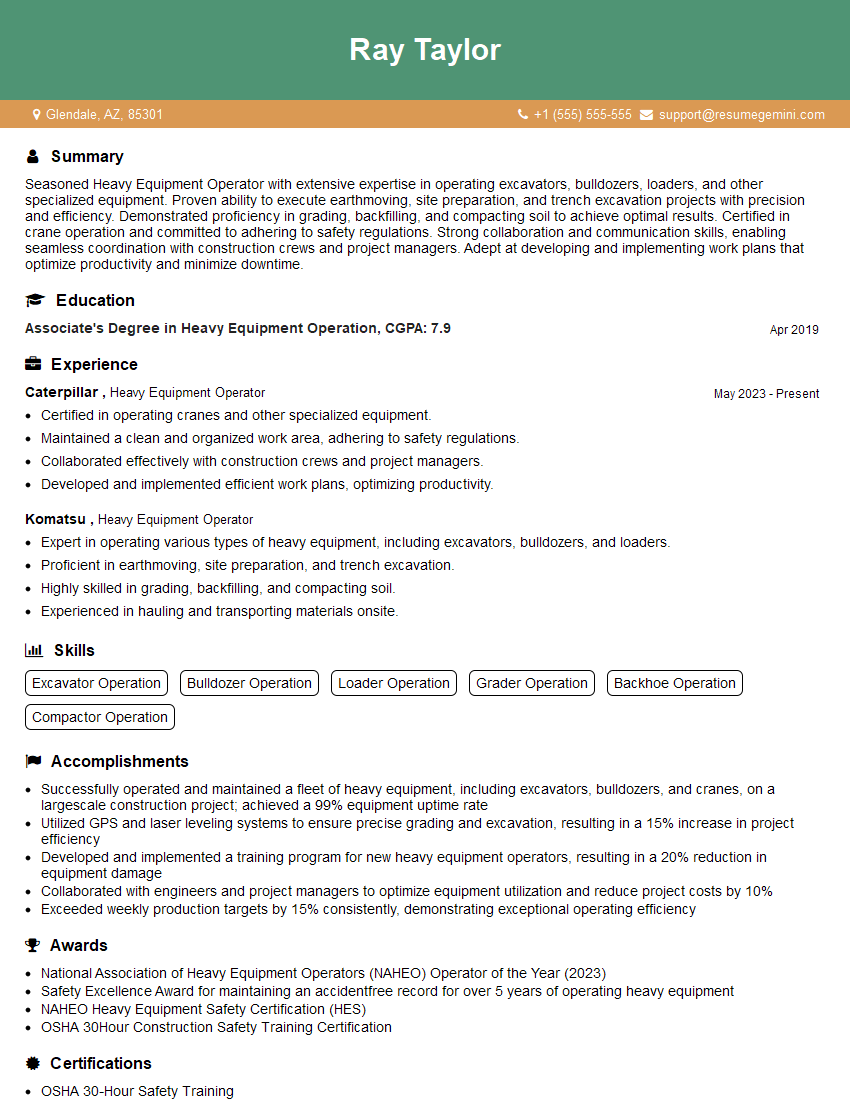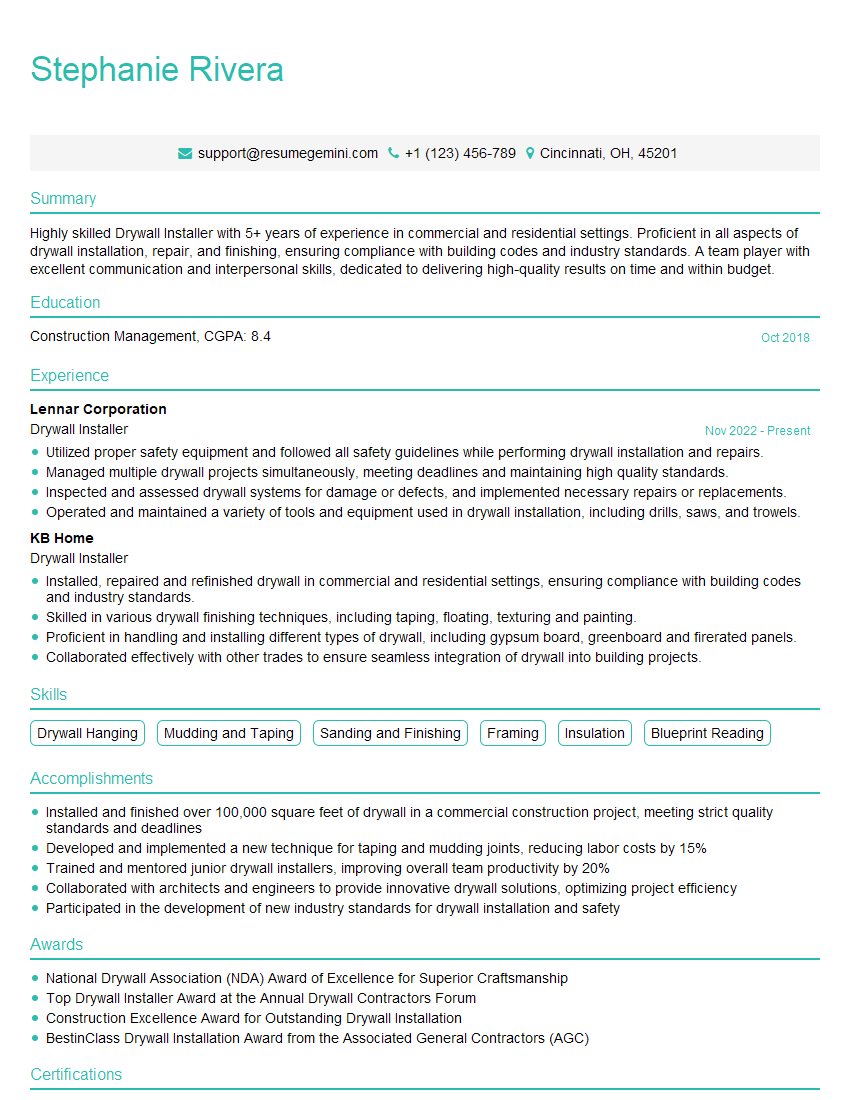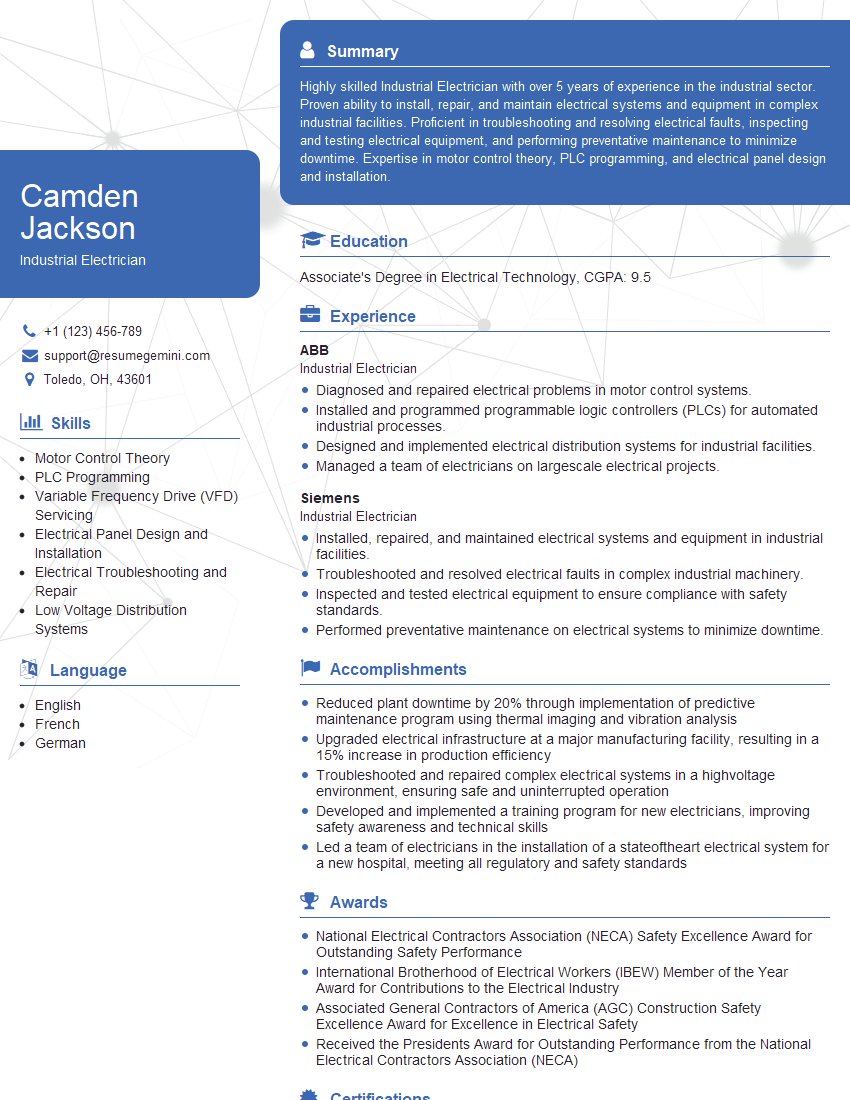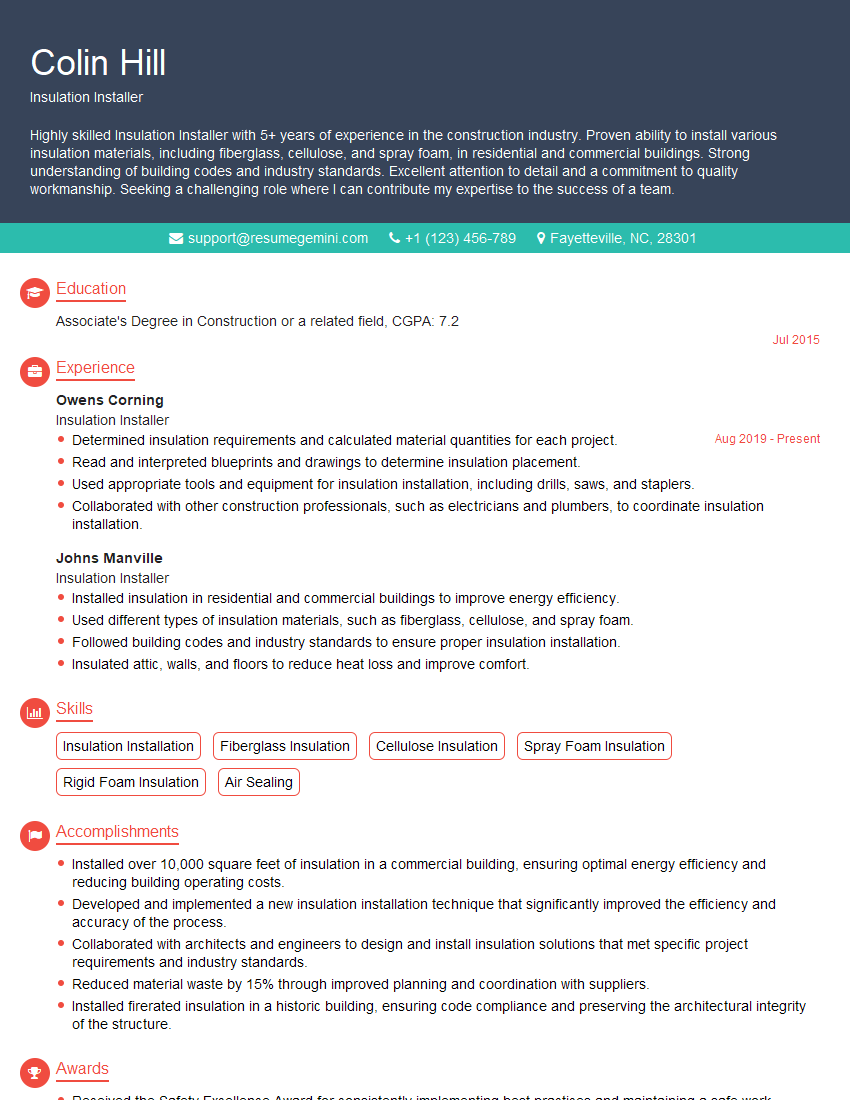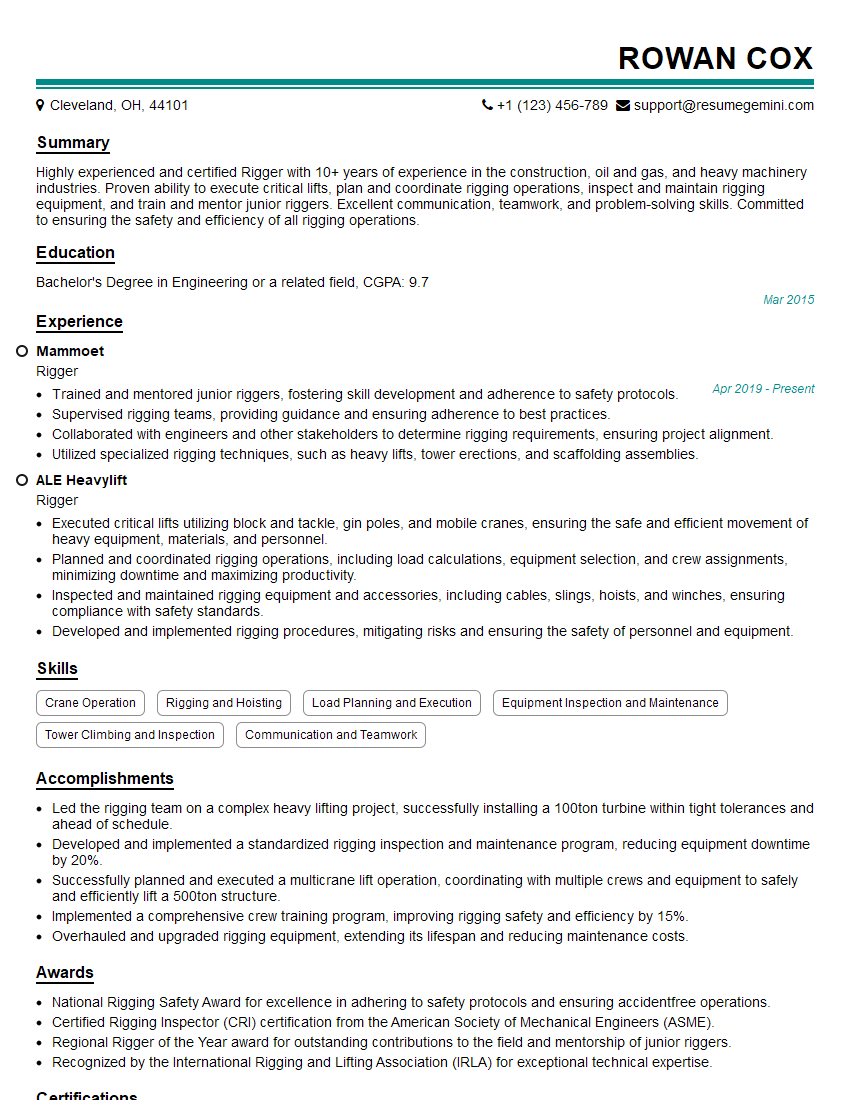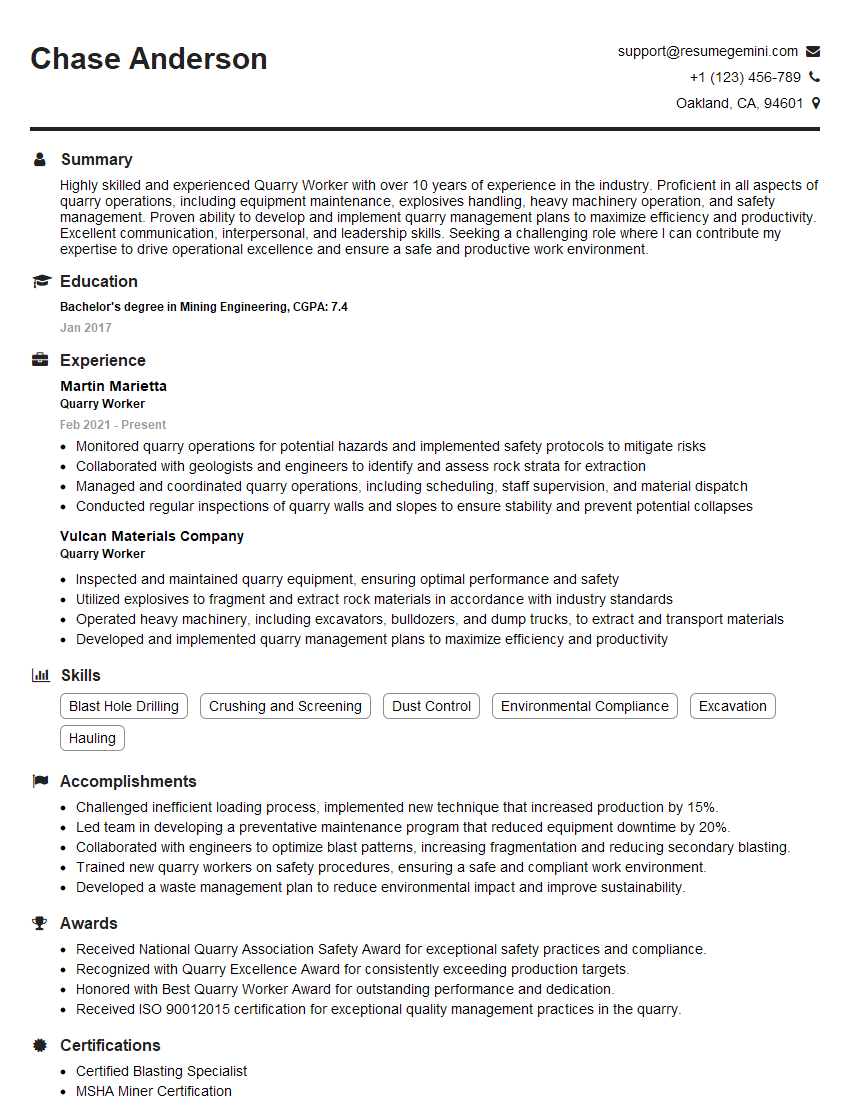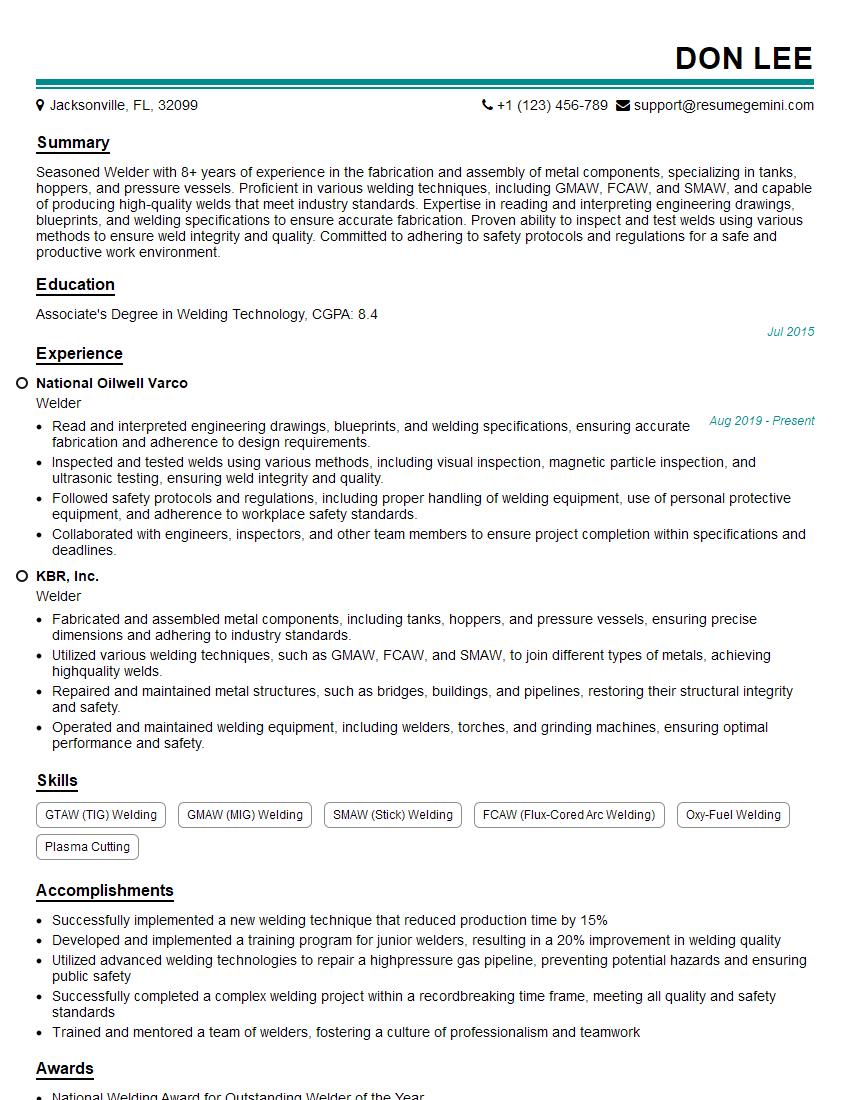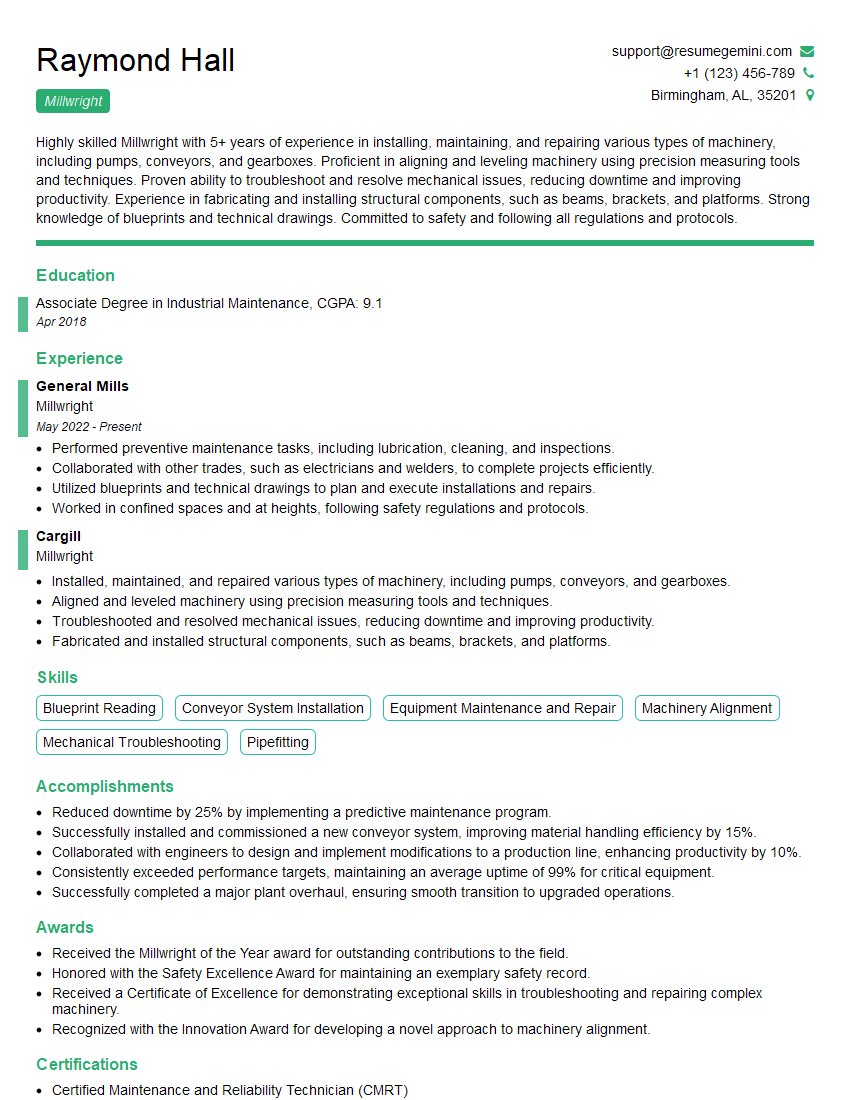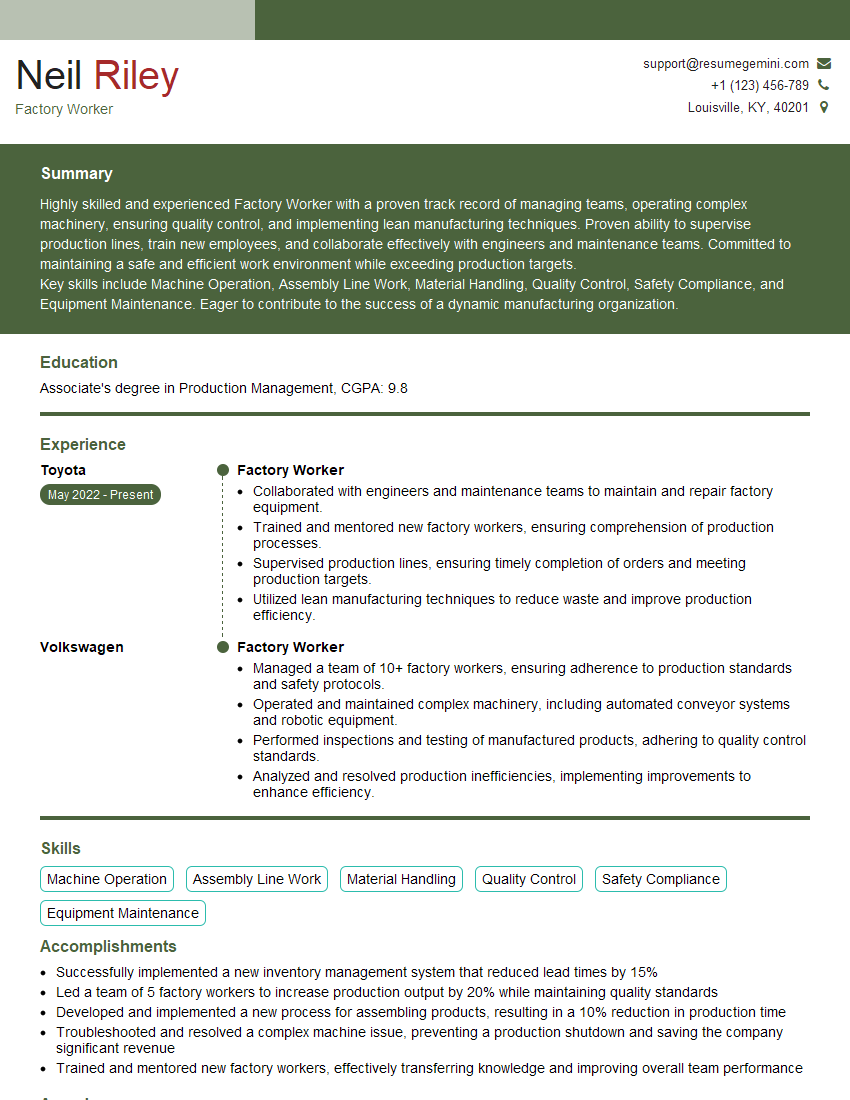Interviews are more than just a Q&A session—they’re a chance to prove your worth. This blog dives into essential Ability to work in a dusty and noisy environment interview questions and expert tips to help you align your answers with what hiring managers are looking for. Start preparing to shine!
Questions Asked in Ability to work in a dusty and noisy environment Interview
Q 1. Describe your experience working in dusty conditions. What safety measures did you employ?
My experience in dusty conditions spans several years working on demolition and construction sites. I’ve worked extensively with materials like concrete, drywall, and asbestos abatement. Safety is paramount in these environments. The measures I consistently employ include:
- Respiratory Protection: I always use appropriate respirators, such as N95 masks for general dust or more specialized respirators with HEPA filters for finer particles or hazardous materials. The choice of respirator depends on the specific dust type and concentration.
- Eye Protection: Safety glasses or goggles are essential to protect my eyes from flying debris and dust particles. I ensure a proper seal to prevent dust ingress.
- Clothing: I wear long-sleeved shirts and pants, preferably made of dust-resistant material, to minimize skin exposure. A dust mask or full face respirator is also part of the protective clothing that I wear.
- Regular Cleaning: Frequent cleaning of work areas helps to reduce dust accumulation. This often includes using industrial vacuums with HEPA filters to prevent the re-suspension of dust.
- Dust Suppression: When possible, we use water sprays or other dust suppression techniques during demolition or excavation to minimize airborne dust.
For example, during an asbestos abatement project, we used specialized negative pressure enclosures and followed stringent protocols to prevent the spread of asbestos fibers, going beyond typical dust control measures.
Q 2. How do you protect your hearing in a noisy work environment?
Hearing protection is non-negotiable in noisy environments. I regularly use hearing protection, choosing the appropriate type based on the noise level and duration of exposure. My approach includes:
- Hearing Protection Selection: I use earplugs or earmuffs, often combining both for maximum protection in extremely loud environments. The selection depends on the noise levels present (determined by noise meters); earplugs are often sufficient for moderate noise and earmuffs offer superior protection from high-decibel sounds.
- Proper Fit: Ensuring a proper fit is crucial for effectiveness. I check the fit of both earplugs and earmuffs before commencing work and throughout to maintain an effective seal.
- Regular Maintenance: I maintain and clean my hearing protection regularly to keep it in optimal condition and extend its lifespan, discarding damaged or worn-out equipment.
- Hearing Conservation Program Participation: I actively participate in any hearing conservation programs that might be offered, such as hearing tests and training to manage noise-related hazards.
Think of hearing protection like wearing a seatbelt – you might not always ‘need’ it, but the protection provided is invaluable in the event something goes wrong.
Q 3. What types of respiratory protection are you familiar with and when would you use each?
I’m familiar with various types of respiratory protection, and my choice is always based on the specific hazard. Here’s a breakdown:
- Dust Masks (N95, etc.): These are disposable masks that filter out at least 95% of airborne particles. I use them for general dust, such as drywall dust or non-toxic wood dust.
- HEPA Filter Respirators: These offer superior filtration, removing even finer particles. I use these for asbestos abatement, working with silica dust, or other fine dusts posing a higher health risk.
- Full-Face Respirators: These provide protection for both the nose and mouth, and often include eye protection. They’re ideal for situations with high dust concentrations or when dealing with hazardous materials like chemicals or gases.
- Supplied-Air Respirators (SARs): In extreme situations with high concentrations of hazardous substances, supplied-air respirators providing fresh air from a separate source are used. These offer the highest level of protection, often used in confined spaces or emergency situations.
The choice depends on the dust type, concentration, and the specific regulations for the job. A job safety analysis (JSA) guides selection. For example, if dealing with asbestos, a HEPA-filtered full face respirator and appropriate protective clothing are mandatory, whereas working with wood dust may only necessitate an N95 mask.
Q 4. Have you ever experienced a dust-related incident or near miss? Describe the situation and the corrective actions taken.
Yes, I once experienced a near miss related to dust exposure. We were demolishing a building, and a large cloud of dust unexpectedly erupted when a section of the wall collapsed. Fortunately, everyone was wearing appropriate respiratory protection. However, it highlighted a gap in our dust control measures.
Corrective Actions: We immediately stopped work and conducted a thorough safety review. We implemented additional dust suppression measures, including more frequent water spraying and the use of dust barriers to prevent unexpected dust clouds. We also revised our safety protocols to include specific procedures for unexpected events, such as wall collapses, and improved communication between workers.
Q 5. How do you maintain your focus and concentration in a noisy environment?
Maintaining focus in a noisy environment requires conscious effort and strategy. I utilize techniques such as:
- Minimize Distractions: I focus on the task at hand, eliminating unnecessary chatter and distractions as much as possible.
- Structured Breaks: Regular short breaks help me to refocus and avoid mental fatigue. During these breaks I move to quieter areas.
- Active Listening and Communication: I pay close attention to verbal instructions and utilize clear communication with my colleagues.
- Regular Safety Checks: I conduct periodic self-checks and safety checks to ensure I am completing tasks effectively and efficiently without increasing risk due to lack of focus.
It’s like a concert—while the music is loud, you can still follow the performance by focusing on the specific musician or section that interests you most.
Q 6. Describe a time you had to work long hours in a dusty and noisy environment. What strategies did you use to manage fatigue?
During a large-scale demolition project, I worked 12-hour shifts for several weeks in dusty and noisy conditions. To manage fatigue, I focused on these strategies:
- Hydration and Nutrition: I drank plenty of water throughout the day and consumed nutritious meals and snacks to maintain energy levels.
- Regular Breaks: I took short breaks to rest and rehydrate, moving to quieter areas whenever possible.
- Teamwork and Support: Working collaboratively with my team helped to maintain morale and productivity. We supported each other during challenging times.
- Prioritization of Tasks: I focused on the most important tasks to avoid unnecessary work and ensure I worked efficiently.
- Proper Sleep: After long days of work, I ensured I had adequate sleep to allow my body to repair and recover.
Managing fatigue is crucial to maintaining safety. Without sufficient rest, errors are more likely to occur.
Q 7. What are the common health risks associated with working in dusty and noisy environments?
Working in dusty and noisy environments poses several health risks:
- Respiratory Diseases: Prolonged exposure to dust can lead to silicosis (from silica dust), asbestosis (from asbestos fibers), or other respiratory illnesses. It can cause inflammation in the lungs (pneumonia).
- Hearing Loss: Noise exposure can cause permanent hearing damage, ranging from tinnitus (ringing in the ears) to complete hearing loss.
- Eye Irritation and Damage: Dust particles can irritate the eyes, leading to dryness, redness, and potential damage.
- Skin Problems: Certain dusts can cause skin irritation, dermatitis, or allergic reactions.
- Fatigue and Stress: The constant noise and challenging conditions can contribute to fatigue, stress, and reduced overall well-being.
Understanding these risks and implementing appropriate safety measures is critical for preventing long-term health problems. Regular health check-ups and participation in any workplace health and safety programs are highly recommended.
Q 8. How would you assess the noise levels in a workplace to ensure compliance with safety regulations?
Assessing workplace noise levels involves a multi-step process to ensure compliance with safety regulations. First, we identify noise sources – machinery, tools, and even general workplace activity. Next, we use a calibrated sound level meter to measure the noise levels in decibels (dB). This isn’t a one-time measurement; we need to take readings at various times and locations, accounting for varying work activities. The readings are then compared against the permissible exposure limits (PELs) set by OSHA (Occupational Safety and Health Administration) or equivalent regulations in the specific region. These PELs are typically expressed as a time-weighted average (TWA) over an eight-hour workday. If the readings exceed the PELs, we need to implement noise reduction strategies, which could include engineering controls (e.g., noise barriers, quieter machinery), administrative controls (e.g., job rotation, limiting exposure time), or personal protective equipment (PPE) such as hearing protection. Finally, all measurements and implemented controls should be documented for compliance purposes. For example, in a previous role at a construction site, we discovered elevated noise levels from a jackhammer. We addressed this by implementing a rotation schedule for workers operating the jackhammer and providing high-fidelity earplugs. Regular monitoring confirmed compliance after these changes.
Q 9. What are your preferred methods for cleaning and maintaining equipment in a dusty environment?
Cleaning and maintaining equipment in dusty environments requires a systematic approach. It starts with using appropriate PPE – respirators, safety glasses, and gloves – to protect myself from the dust. The next crucial step is using the correct cleaning methods. Compressed air, while convenient, can spread dust if not used carefully. Therefore, I favor methods like vacuuming with a HEPA-filtered vacuum cleaner to minimize dust dispersal. Regular wiping down with damp cloths, followed by careful application of appropriate lubricants where necessary is vital. Equipment should also be disassembled regularly for thorough cleaning, especially in areas that are difficult to reach. Preventative maintenance, like regular lubrication and tightening of bolts, minimizes the creation of dust caused by friction and wear. For instance, during my time working in a quarry, we utilized a specialized cleaning station with HEPA-filtered vacuuming system coupled with high-pressure washing for larger pieces of equipment. This prevented dust from becoming airborne and reduced the potential for equipment failure.
Q 10. Describe your experience with using personal protective equipment (PPE) in a dusty and noisy environment.
My experience with PPE in dusty and noisy environments is extensive. This includes the consistent and correct use of respirators (N95 or better, selected based on the specific type of dust), hearing protection (earplugs or muffs with appropriate Noise Reduction Ratings or NRR), safety glasses to protect against flying debris, and gloves to protect hands from dust and potential irritants. I understand the critical importance of proper fit and maintenance of PPE. A poorly fitting respirator is ineffective, and a damaged earplug offers no protection. Regular inspections of PPE and prompt replacement when necessary are paramount. I’ve trained others on the proper use and care of PPE, emphasizing the health risks associated with inadequate protection. One memorable instance was when a colleague’s respirator was found to be damaged. This highlighted the importance of regular checks and replacement as a crucial safety precaution for our team.
Q 11. How familiar are you with different types of dust and their potential health hazards?
I’m familiar with various types of dust and their associated health hazards. Different dusts pose unique risks depending on their composition. Silica dust (crystalline silica), for example, can cause silicosis, a serious lung disease. Asbestos dust is a known carcinogen, leading to lung cancer and mesothelioma. Wood dust can cause allergic reactions and respiratory problems. Metal dusts, depending on the metal, can have various toxicity levels. Knowing the type of dust present in a workplace is crucial to selecting the appropriate PPE and implementing necessary control measures. Respiratory protection needs to be tailored to the specific dust, choosing respirators with the right filters. Regular monitoring of air quality, including dust sampling and analysis, can help in identifying the specific dust type and its concentration. This information allows for better risk assessment and a more effective implementation of control measures.
Q 12. Explain the importance of regular equipment maintenance in preventing dust-related issues.
Regular equipment maintenance is crucial for preventing dust-related issues. Well-maintained equipment operates more efficiently, reducing wear and tear which, in turn, minimizes dust generation. Regular lubrication of moving parts reduces friction, a major source of dust in many mechanical processes. Cleaning and replacing worn parts prevents the release of dust particles from degrading components. Proper sealing of equipment helps contain dust, preventing it from escaping into the environment. Neglecting maintenance can lead to increased dust generation, equipment failure and potentially more serious accidents, increasing the risk of both environmental contamination and worker exposure. For example, in a previous role, neglecting to replace worn bearings in a conveyor belt led to increased friction, a noticeable increase in dust production, and ultimately to a complete system breakdown.
Q 13. How do you communicate effectively in a noisy environment?
Communicating effectively in a noisy environment requires employing various strategies. Firstly, I use clear and concise language. I ensure that my instructions and messages are unambiguous. Visual aids, like hand signals or written notes, can greatly enhance communication. When speaking directly to someone, I try to get close enough to be heard clearly. I make sure I have the other person’s attention before I start speaking. In many noisy environments, the use of two-way radios or other communication devices is essential. Furthermore, I ensure that my communication adapts to the noise levels. For example, I might shout instructions in a very noisy environment, which is not usually preferred, but absolutely necessary for safety.
Q 14. Have you ever worked with noise-canceling equipment or technology? Describe your experience.
Yes, I have experience working with noise-canceling equipment. In one project, we utilized noise-canceling headphones to protect workers from sustained high-noise levels during operation of certain machinery. These headphones significantly reduced the noise exposure, thereby increasing worker comfort and improving hearing protection. While the headphones were primarily used for hearing protection, they also reduced the amount of general workplace noise. This allowed for better communication and concentration. However, it’s important to note that noise-canceling headphones aren’t a complete replacement for proper hearing protection in all situations; they should be chosen based on the specific noise profile and risk assessment. It’s also crucial to maintain awareness of the surrounding environment, as they can limit your ability to hear warning signals or other critical sounds from the vicinity.
Q 15. What are some strategies for minimizing dust generation during work tasks?
Minimizing dust generation requires a multi-pronged approach focusing on source control, containment, and cleanup. Think of it like containing a spill – you want to stop the source, prevent it from spreading, and then clean up what’s left.
- Source Control: This involves using techniques that reduce dust at its origin. For example, using water sprays during demolition or excavation to dampen materials and prevent them from becoming airborne. Another example is using pre-wetting techniques before working with dry materials like concrete or sand.
- Containment: This aims to prevent dust from spreading. Methods include using enclosures around work areas, using HEPA (High-Efficiency Particulate Air) filtered vacuums instead of brooms, and employing dust suppression systems. Imagine working inside a giant, filtered box to keep dust particles confined.
- Cleanup: Regular and thorough cleanup is crucial. Using appropriate cleaning tools, such as HEPA filtered vacuums and damp mops, is critical. Sweeping only stirs up dust, spreading the problem.
Implementing these strategies is crucial to creating a safer and healthier work environment. The key is to consider dust control from the planning phase onwards, not just as an afterthought.
Career Expert Tips:
- Ace those interviews! Prepare effectively by reviewing the Top 50 Most Common Interview Questions on ResumeGemini.
- Navigate your job search with confidence! Explore a wide range of Career Tips on ResumeGemini. Learn about common challenges and recommendations to overcome them.
- Craft the perfect resume! Master the Art of Resume Writing with ResumeGemini’s guide. Showcase your unique qualifications and achievements effectively.
- Don’t miss out on holiday savings! Build your dream resume with ResumeGemini’s ATS optimized templates.
Q 16. How would you identify and report unsafe noise levels or dust conditions?
Identifying unsafe noise or dust levels requires a combination of monitoring and observation. Think of it like a detective investigating a crime scene – you need to gather evidence and report your findings.
- Noise Monitoring: Using calibrated sound level meters to measure decibel (dB) levels throughout the workday provides quantitative data. This data can then be compared to OSHA permissible exposure limits.
- Dust Monitoring: Using air sampling pumps with appropriate filters to collect dust samples allows for laboratory analysis of dust concentrations and particle size distribution. This gives you precise data on the type and amount of dust present.
- Visual Inspection: Observing visible dust clouds, worker discomfort, or evidence of equipment malfunction are also important indicators. This is akin to observing for visual cues that something is amiss.
Once unsafe conditions are identified, immediate action should be taken, and the findings should be formally reported to the supervisor, safety officer, or relevant authority, along with any proposed solutions.
Q 17. Describe your understanding of OSHA regulations concerning noise and dust exposure.
OSHA (Occupational Safety and Health Administration) regulations are designed to protect workers from the harmful effects of noise and dust. They set permissible exposure limits (PELs) and require employers to implement control measures to keep exposures below these limits. These limits are based on extensive research linking exposure to various health problems.
- Noise Exposure: OSHA specifies PELs for noise exposure in decibels (dB) over an 8-hour workday. Exceeding these limits necessitates engineering controls like noise reduction barriers, administrative controls like limiting exposure time, and the use of hearing protection.
- Dust Exposure: OSHA sets PELs for various types of dust, such as silica, asbestos, and coal dust. These limits are usually expressed as milligrams per cubic meter (mg/m³) of air. Control measures can include engineering controls such as ventilation systems, administrative controls like work rotation, and personal protective equipment (PPE) such as respirators.
Employers are required to monitor employee exposures, provide training on hazard awareness and PPE use, and maintain accurate records of exposure levels. Failure to comply can result in significant penalties.
Q 18. What are the potential long-term health consequences of prolonged exposure to noise and dust?
Prolonged exposure to noise and dust can have significant long-term health consequences. Imagine a cumulative effect, each day adding to the potential damage.
- Noise-Induced Hearing Loss (NIHL): Prolonged exposure to loud noise damages the delicate hair cells in the inner ear, leading to permanent hearing loss, tinnitus (ringing in the ears), and hyperacusis (increased sensitivity to sound).
- Respiratory Diseases: Inhalation of dust can cause a range of respiratory problems, including silicosis (from silica dust), asbestosis (from asbestos fibers), and coal worker’s pneumoconiosis (black lung disease). These diseases often lead to chronic coughing, shortness of breath, and reduced lung function.
- Other Health Issues: Certain dusts can cause other health issues, including cancer (e.g., mesothelioma from asbestos), skin irritation, and eye problems. Noise can also contribute to stress, anxiety, and sleep disturbances.
Early detection and prevention are vital in minimizing these risks. Regular health check-ups, adherence to safety protocols, and proper use of PPE are essential.
Q 19. How do you adapt your work methods to reduce exposure to noise and dust?
Adapting work methods to reduce exposure involves proactive planning and practical application of best practices. It’s about smart work, not just hard work.
- Work Scheduling: Rotating workers through noisy or dusty tasks reduces individual exposure. It’s like sharing the load to prevent burnout.
- Using appropriate tools and equipment: Using tools and equipment designed for dust and noise suppression is crucial. This includes using low-noise equipment, applying water sprays to reduce dust generation, and utilizing HEPA filtered vacuums.
- Implementing engineering controls: This could involve modifying the workplace layout to minimize dust dispersion, installing ventilation systems, or erecting noise barriers. This is about designing the environment to reduce exposure.
- PPE usage: This includes using hearing protection (earplugs or muffs), respirators, and protective eyewear as needed. Think of this as your armor against the hazards.
Constant awareness and a commitment to using the best available methods are key to significantly minimizing exposure.
Q 20. What are your strategies for staying hydrated and maintaining energy levels in challenging work conditions?
Staying hydrated and maintaining energy levels in challenging work conditions is critical for both safety and productivity. It’s like refueling a vehicle to ensure optimal performance.
- Hydration: Frequent water breaks are essential. Dehydration can lead to fatigue, dizziness, and reduced cognitive function. Carrying a water bottle and actively drinking water throughout the workday is crucial. Electrolyte drinks can also help replenish lost minerals.
- Nutrition: Consuming nutritious meals and snacks provides sustained energy. Avoid heavy meals that can lead to sluggishness. Opt for lighter, energy-boosting foods like fruits, vegetables, and lean protein.
- Rest Breaks: Short, frequent rest breaks allow for recovery and reduce fatigue. Even a few minutes in a shaded, less noisy area can make a difference.
- Personal Fitness: Maintaining a good level of physical fitness increases endurance and resilience to demanding conditions. This can lead to enhanced stamina and reduced susceptibility to fatigue.
Prioritizing hydration and nutrition, combined with adequate rest, ensures physical and mental well-being in challenging environments.
Q 21. Describe a time you had to troubleshoot a problem in a difficult work environment.
During a large demolition project, a crucial piece of equipment, a large excavator, malfunctioned during peak noise and dust levels. The problem resulted in a significant work stoppage.
The initial diagnosis pointed to a hydraulic system failure – a challenging situation given the loud noises of other equipment in operation and the thick dust cloud surrounding the excavator. I systematically began troubleshooting:
- Safety First: I ensured all personnel were clear of the immediate area and implemented additional safety measures to address the dust and noise conditions (e.g., additional respiratory protection). Safety is paramount in any troubleshooting effort.
- Visual Inspection: Despite the challenging conditions, I conducted a careful visual inspection of visible hydraulic lines and components, looking for any signs of leaks or damage. While conditions were not ideal, careful observation was key.
- Systematic Checking: I used a diagnostic tool to check the hydraulic pressure and flow rates, comparing them against the equipment’s specifications. I started with obvious checks and followed a logical progression.
- Identifying the Root Cause: I discovered a small but critical leak in a hydraulic hose near the machinery’s joint. The leak was hard to spot due to the dust and noise conditions but resulted in a catastrophic loss of pressure in the system.
- Solution and Restoration: After replacing the hose and rechecking the entire hydraulic system, the excavator was restored to full operational capacity. Post-fix, I documented the incident with recommendations to improve maintenance and reduce the potential for future issues.
This experience highlighted the importance of methodical troubleshooting, prioritizing safety in challenging conditions, and the value of comprehensive documentation for continuous improvement.
Q 22. How do you prioritize safety when working in a noisy and dusty environment?
Prioritizing safety in noisy and dusty environments is paramount. It’s not just about following rules; it’s about developing a safety-first mindset. This involves a multi-pronged approach encompassing personal protective equipment (PPE), work practices, and proactive hazard identification.
- PPE Selection and Use: Always choose the appropriate PPE for the specific dust and noise levels. This includes respirators (N95, half-face, full-face, depending on the type and concentration of dust), hearing protection (earplugs or muffs with appropriate noise reduction rating – NRR), safety glasses, and sturdy work boots.
- Work Practices: Maintain a clean workspace to minimize dust. Use dust suppression techniques like misting or vacuuming. Follow established procedures for handling machinery and materials to reduce noise and dust generation. Take regular breaks to prevent fatigue, a major contributor to accidents.
- Hazard Identification and Mitigation: Regularly inspect the work area for potential hazards like loose materials, exposed wires, or equipment malfunctions. Report any unsafe conditions immediately to your supervisor. Understand the specific hazards present in your work environment (e.g., silica dust, asbestos, high-frequency noise) and how to mitigate them.
Think of it like this: safety isn’t a one-time action; it’s a continuous process of vigilance and adaptation. Just as a pilot performs pre-flight checks, I perform a safety check of my equipment and workspace before beginning any task.
Q 23. What steps would you take to ensure your colleagues’ safety in a noisy and dusty work environment?
Ensuring colleagues’ safety is as crucial as protecting my own. It involves leadership, communication, and active participation in a safe work environment.
- Leading by Example: I always demonstrate proper PPE use and safe work practices. My actions speak louder than words and encourage others to follow suit.
- Communication and Training: I actively participate in safety training and readily share my knowledge with colleagues. If I notice someone not using PPE correctly, I politely remind them of the importance of safety and offer assistance.
- Collaboration and Reporting: I collaborate with colleagues to identify and address hazards. I promptly report any unsafe conditions or near-miss incidents, as early detection is key to prevention.
- Teamwork: A buddy system, where workers look out for each other, can be remarkably effective in preventing accidents.
Remember, a safe work environment is a collective responsibility. It’s about building a culture where safety is everyone’s priority.
Q 24. Describe your experience using various types of dust masks and respirators.
My experience with dust masks and respirators spans several types, each suited for different dust levels and particle sizes. I’ve used disposable N95 respirators for general dust, half-face respirators with replaceable filters for higher dust concentrations, and full-face respirators with specialized filters for situations with potentially harmful substances.
- N95 Respirators: Excellent for common dust, but their effectiveness is limited in high-concentration environments.
- Half-face Respirators: Offer better protection than N95s, with replaceable cartridges allowing for adaptation to various dust types.
- Full-face Respirators: Provide the highest level of protection, shielding both eyes and face. Essential when dealing with hazardous dusts or fumes.
Proper respirator selection depends on a thorough hazard assessment, and fit testing is crucial to ensure a proper seal and prevent leakage. I always follow manufacturer instructions and receive appropriate training before using any respirator.
Q 25. How do you ensure the proper fit and functionality of your hearing protection?
Hearing protection is vital in noisy environments. Ensuring proper fit and functionality is a key part of protecting my hearing.
- Fit Testing: I regularly check the fit of my earplugs or muffs to ensure a tight seal, minimizing noise penetration. For muffs, proper placement and adjustment are key. For earplugs, I ensure they are inserted correctly and comfortably.
- Functionality Check: I inspect my hearing protection for any damage or deterioration. Cracked or worn earplugs or muffs are replaced immediately. I also verify the Noise Reduction Rating (NRR) is appropriate for the noise levels in my work area.
- Maintenance: Disposable earplugs are replaced regularly. Reusable earplugs and muffs are cleaned and stored correctly to prolong their lifespan and maintain hygiene.
Regular hearing tests are also essential to monitor hearing health. Protecting my hearing is a long-term investment in my well-being.
Q 26. What are some non-pharmaceutical ways you maintain your health while working in a demanding environment?
Maintaining health in a demanding environment requires a holistic approach beyond medication. It’s about proactive strategies that support both physical and mental well-being.
- Hydration and Nutrition: I prioritize drinking plenty of water throughout the day to stay hydrated and avoid dehydration, a common problem in dusty environments. I also focus on a balanced diet rich in fruits, vegetables, and whole grains to provide the energy and nutrients my body needs.
- Regular Exercise: Even outside of work hours, I dedicate time to physical activity, be it jogging, gym workouts, or simply a walk. This helps maintain physical fitness and reduces stress.
- Stress Management: I employ various stress-reducing techniques, including meditation, mindfulness, or simply taking short breaks to relax and clear my mind. This is crucial for overall health and prevents burnout.
- Sleep: Adequate sleep is fundamental for physical and cognitive restoration. I prioritize getting 7-8 hours of quality sleep each night.
Think of it like maintaining a machine; regular upkeep is essential for optimal performance and longevity. My body is my most valuable asset, and I treat it accordingly.
Q 27. How do you handle unexpected events or emergencies in a noisy environment?
Handling unexpected events in a noisy environment requires quick thinking and efficient communication. Visual cues and pre-established emergency procedures become even more crucial.
- Visual Communication: In noisy situations, visual signals like hand signals or bright warning lights are often more effective than verbal communication.
- Emergency Procedures: I’m thoroughly familiar with all emergency procedures, including evacuation plans and reporting protocols. This preparation allows for a swift and coordinated response.
- Clear Communication Strategies: If verbal communication is necessary, I ensure I speak clearly and directly, perhaps using a written message if the noise level prevents verbal comprehension.
- Situational Awareness: Maintaining situational awareness is crucial; I pay attention to my surroundings and the actions of colleagues to anticipate potential problems.
A good analogy is a fire drill. Practice makes perfect, and regular training ensures that we’re prepared to react efficiently and safely in an emergency.
Q 28. Describe a time you had to make a quick, critical decision in a challenging work setting.
During a demolition project, a large section of a wall unexpectedly collapsed, creating a significant dust cloud and posing a risk to nearby workers. I quickly assessed the situation. The immediate concern was ensuring the safety of my colleagues, who were momentarily blinded and disoriented by the dust cloud.
My decision was to instantly signal a halt to all work using hand signals, given the noise level made verbal commands impractical. I then guided my team to a safe location upwind of the dust cloud while simultaneously notifying the site supervisor of the incident. The quick action prevented any injuries, and the situation was swiftly resolved. This incident reinforced the importance of clear communication, rapid response, and pre-planned emergency protocols in a high-risk environment.
Key Topics to Learn for Ability to work in a dusty and noisy environment Interview
- Understanding the Hazards: Learn about the specific health risks associated with dust and noise exposure, including respiratory illnesses, hearing loss, and potential long-term health effects. Research relevant safety regulations and standards.
- Personal Protective Equipment (PPE): Familiarize yourself with various types of PPE used in dusty and noisy environments (e.g., respirators, earplugs, safety glasses). Understand their proper use, limitations, and maintenance.
- Safety Procedures and Protocols: Study standard operating procedures for working in these environments, including emergency response plans, communication protocols, and safe work practices to mitigate risks.
- Maintaining Equipment and Workspaces: Explore the importance of maintaining equipment to minimize dust and noise generation. Understand the role of regular cleaning and preventative maintenance in a safe work environment.
- Health Monitoring and Reporting: Learn about the importance of regular health checkups and reporting any potential health concerns related to dust and noise exposure. Understanding the reporting process is crucial.
- Adaptability and Resilience: Discuss your ability to work effectively in challenging conditions, highlighting your stamina, problem-solving skills in stressful situations, and your capacity to adapt to changing circumstances.
Next Steps
Mastering the ability to work effectively in dusty and noisy environments significantly enhances your employability across various industries. It demonstrates your commitment to safety, your resilience, and your practical skills. To increase your chances of landing your dream job, create an ATS-friendly resume that highlights these crucial skills. ResumeGemini is a trusted resource to help you build a professional resume that showcases your qualifications effectively. We provide examples of resumes tailored to emphasize your ability to thrive in dusty and noisy work environments to help you get started.
Explore more articles
Users Rating of Our Blogs
Share Your Experience
We value your feedback! Please rate our content and share your thoughts (optional).
What Readers Say About Our Blog
Hi, I’m Jay, we have a few potential clients that are interested in your services, thought you might be a good fit. I’d love to talk about the details, when do you have time to talk?
Best,
Jay
Founder | CEO
